ASUS K53E: Testing Dual-Core Sandy Bridge
by Jarred Walton on April 8, 2011 1:00 AM EST- Posted in
- Laptops
- Intel
- Sandy Bridge
- Asus
General Performance – Dual-Core Sandy Bridge vs. the World
So now we get to the numbers, and this is where some of the competing solutions will really take a beating. Let’s just cut straight to the chase and look at the graphs. We’ve highlighted the K53E in our standard bright green, with the ASUS U41JF in black, Apple's dual-core i5-2415M MBP13 in gold, and the quad-core i7-2820QM in yellow.
One interesting piece of information prior to the benchmark discussion is that despite having a theoretical maximum Turbo speed of 3.2GHz, we rarely see the i5-2520M hit that mark in testing. Using CPUID’s TMonitor utility, in the single-core Cinebench result we see both cores fluctuate between 800 to 3100MHz. It appears the Windows task scheduler isn’t quite sure how to best distribute the load, which is a common problem. However, in the multi-threaded Cinebench test the two CPU cores run at a constant 2.9GHz, as expected.

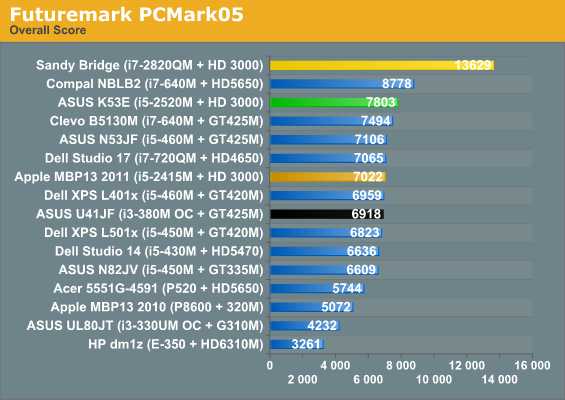
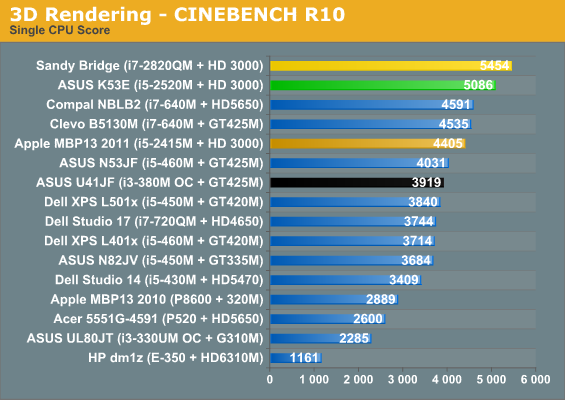
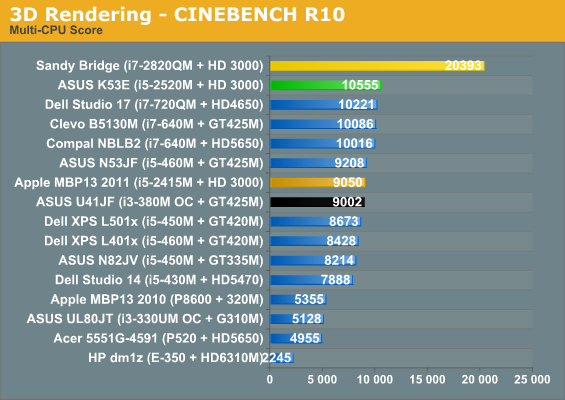
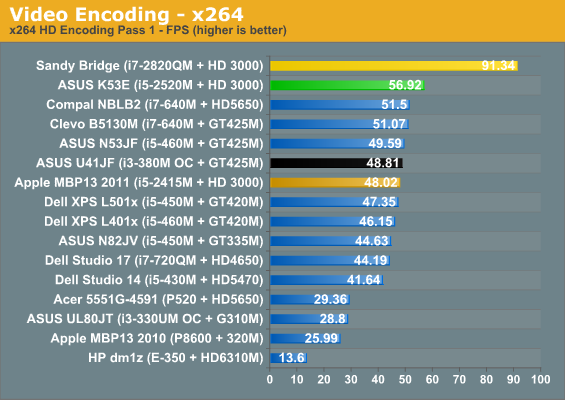

Starting with the new MBP13 comparison, the K53E with i5-2520M comes out an average of 20% faster. Some of that can be attributed to the hard drive differences, as PCMark Vantage shows Apple’s HDD choice is particularly poor, but the CPU intensive tasks are also 15 to 25% faster. It’s interesting that ASUS’ UL41JF happens to put in an overall showing in these applications that matches the MBP13, but that’s in a large part thanks to the 15% overclock. Looking at stock Arrandale CPUs, the i5-2520M turns in slightly higher performance results than the i7-640M, the highest-clocked Arrandale CPU we’ve tested. Even the old i7-720QM in the Dell Studio 17 fails to match the performance of the i5-2520M, which leads by an average of 18% in the above benchmarks (with the only loss coming in Pass 2 of x264 encoding).
Move up to quad-core SNB and an SSD, and of course the dual-core parts look a lot weaker. The i7-2820QM average lead in the above charts is 74%, but part of that is the thanks to the 104% lead in PCMark Vantage. Remove the PCMark results, though, and the 2820QM is still 65% faster than the 2520M. On the other side of the charts—literally—is AMD’s E-350. We know it’s not meant to compete with Sandy Bridge (or even Arrandale or Core 2 Duo), but keep in mind that the cheapest price for such a laptop is going to be around $450. On average, the i5-2520M lays the smack down hard and ends up roughly four times faster than an E-350. Ah, but the E-350 has a much better IGP, right? Well, maybe it’s better, but it’s certainly not faster than Intel’s HD 3000 when it’s bottlenecked by the CPU; here are some 3DMark results before we get to the games to give you an idea of how graphics performance compares.
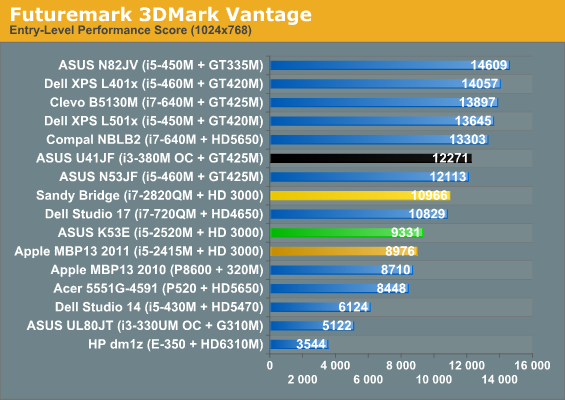
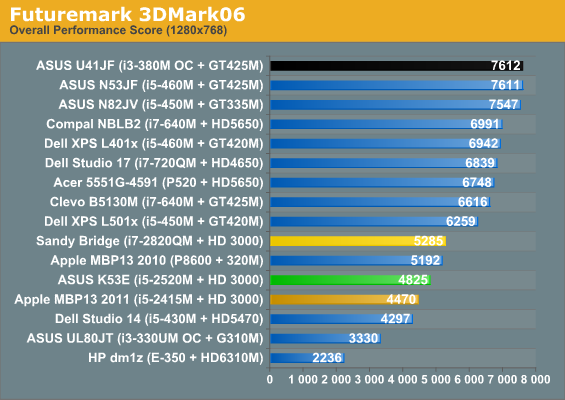
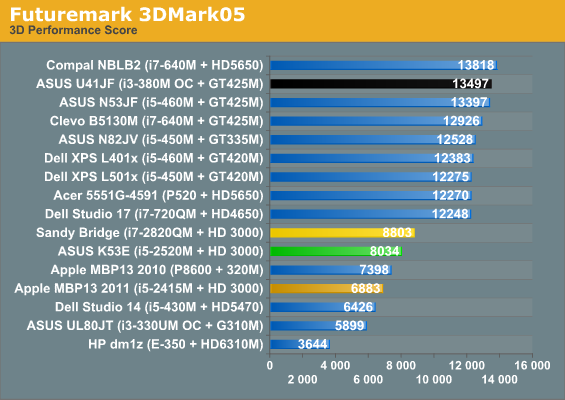
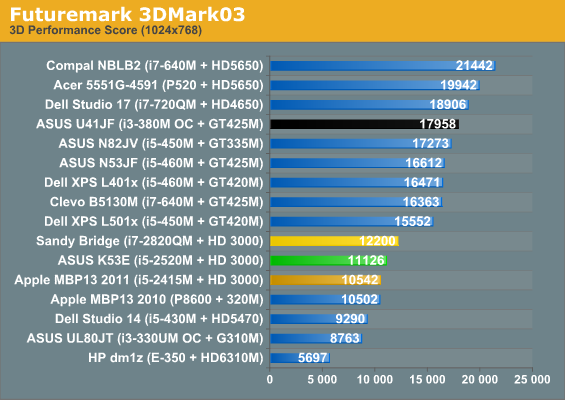
While we would never take 3DMark as the end-all, be-all of graphics performance comparisons, it does give a general idea of what we can expect. The K53E with i5-2520M turns in performance that’s 9% faster than the MBP13 on average across the four versions of 3DMark. That’s actually pretty accurate, as we’ll see in the gaming tests. Likewise, the i7-2820QM results end up being 12% faster than the 2520M, possibly from more aggressive IGP Turbo modes. Again, that matches what we’ll see in the games. On the other hand, even a middling dGPU like the GT 420M/425M still comes out 40-50% ahead of the HD 3000, and AMD’s HD 5650 is 60% faster on average.
What about AMD’s Fusion E-350 platform? If the 3DMark results hold in our actual gaming tests, Intel’s “horrible” HD 3000 IGP offers over twice the performance of the HD 6310M. In fact, even an Arrandale IGP would come within 10% of the E-350 results in 3DMark. It’s not that we love Intel or want them to pummel AMD, and we understand that the E-350 competes in a lower price bracket. Still, many people like to get carried away in discussions of how much better AMD’s graphics are compared to Intel’s IGP. That’s certainly true when you’re looking at discrete GPUs, and compatibility is still better with AMD and NVIDIA drivers, but the latest SNB IGP changed the status quo. HD 3000 works in about 90% of games (roughly estimating), performs well enough to be playable in about 80% of titles, posts scores that are competitive with HD 5470 and GT 320M (and often twice what the current Brazos can achieve), and you get it for free with any 2nd Gen Core i-series CPU. As a friend of mine is fond of saying, it’s hard to compete with “free”.










78 Comments
View All Comments
JarredWalton - Friday, April 8, 2011 - link
I spent almost half the conclusion talking about exactly this. I'm not sure what you want me to say more, other than you'd love for me to sing the praises of AMD and decry Intel has too expensive? Seriously:$300 to $500: Brazos C-50 or E-350 are hard to beat. If you want more performance with less battery life, Athlon/Turion/Phenom II are also available. Or wait a month for Llano and see how that compares.
Above $600, right now there's no way I would recommend Brazos. There's also no way I would recommend a 15.6" Brazos laptop, just like I would laugh at a 15.6" Atom-based system. Brazos E-350 is about twice the CPU performance of Atom, but then CULV was already three times as fast as Atom. I bashed on Atom a lot, and I continue to do so; it's far too easy to beat Atom and thus the real target has to be Pentium and Celeron at the very least. I'm going to see if I can get an Arrandale Pentium or Celeron just to see how it compares, because I expect about 2x the performance of Brazos on the CPU with slightly slower graphics. Well, actually a lot slower, but Bobcat is the bottleneck.
If anyone has $600 to spend on a laptop, they really shouldn't be looking at Brazos. Heck, even $500 is probably too much these days, considering all the options in that price range, unless you want small size and good battery life. If you can stomach the keyboard, Acer has the 1430Z (Pentium U5600) and the 1830T (i3-380UM) that are certainly viable alternatives to E-350.
krumme - Friday, April 8, 2011 - link
With a house full of Intel computers, i am not here to judge Intel as expensive and AMD as cheap. I think the consumers know what they should pay for the benefits if fthey get it presented in a balanced way. And i dont disagree with you recommandations personally.My point is. People can decides for themselves what is good enough for them. They are experts on their own life. If they buy a brazos and dont complain afterwards its fine for me. I have seen so many people getting disapointed by Atom for reasons we all know - no hd youtube and slow surfing. When someone less informed reads this review - perhaps by chance using google - and look at the bottom of the charts - they migt get the impression brazos is the same stuff as Atom. And judged by their standards - their measurements intruments - brazos is very different from Atom. So it would be a wrong assessment from their view.
And yes - right now the oem is ripping of brazos customers because of limited suply, - and because they can. But it just shows how brilliant the product is mm2 vs profitability. And yes AMD positioning this like pentium/celeron perf. is not just bs, but plain stupid for their long time brand building, as is the low performance parts eroding the brandvalue. But this is just AMD marketing performance as usual.
floersch - Friday, April 8, 2011 - link
Your General Performance charts identify the CPU of the Apple MBP13 2011 as an i5-2415M but your Gaming charts identify it as an i5-2515M. Are these two different machines or does one set of charts incorrectly identify the CPU?JarredWalton - Friday, April 8, 2011 - link
It's the 2415M... I'll correct the charts that have the wrong model number.floersch - Friday, April 8, 2011 - link
Thanks, Jarred, for the quick reply and for all of your excellent work. I always look forward to your analyses.vol7ron - Friday, April 8, 2011 - link
I think it's coming pretty close to a decent price point for performance.I'd like to see these laptops ship with a free HD extender/docker. It shouldn't cost the company much and when swapping out that big ol' 5400 for a SSD, it'd be nice to have the device immediately, to dedicate it to backups/storage.
What do you think?
veri745 - Friday, April 8, 2011 - link
Why drop the E-350 from the comparisons when you get to medium settings? I would expect it does a lot better relative to HD 3000 when you start bumping up the graphics settings.silverblue - Friday, April 8, 2011 - link
Not really, because HD 3000 will have access to much more bandwidth than Brazos.JarredWalton - Friday, April 8, 2011 - link
Because our medium settings typically run 25 to 50% slower than our low settings. Brazos manages to hit 30FPS in zero of the eight current games we're testing; do we need to show that it performs even worse at medium? Anyway, I actually did run MSI X370 at Medium settings. You can see the comparison (like many others) in Mobile Bench:http://www.anandtech.com/bench/Product/348?vs=346
silverblue - Friday, April 8, 2011 - link
Think about it... even if Brazos is supposed to be priced much lower than low-end Sandy Bridge laptops, it doesn't follow that it will always work out that way. You shouldn't ever be paying more than $500 for a Brazos machine unless it's a sufficiently high quality build but right now that doesn't seem to be the case all of the time.Toms just made a comparison between three diffferent Brazos laptops ( http://www.tomshardware.com/reviews/gateway-nv51b0... ) and they came to the conclusion that chopping $50 off the price of a lot of these machines could really make Brazos stand out.
What AMD should be doing is advertising Brazos as the true Atom competitor that it should be, at the very most CULV Celerons, instead of falsely positioning it as a competitor to Pentium setups.
Just because such articles highlight overcharging and the advantage of spending not a huge amount more on something far more powerful, that doesn't make it an incorrect assessment. I expect that once there's more Brazos offerings on the market, manufacturers will have to lower prices in order to compete, and then there really will be a gulf in price between Brazos and Sandy Bridge, like there should be.